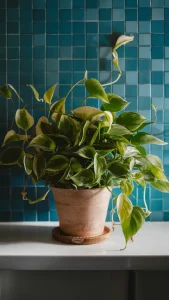If you’re new to houseplants or looking for a low-maintenance green companion, look no further than the pothos plant. Also known as devil’s ivy or golden pothos, this trailing vine is notoriously tough and forgiving, making it the perfect choice for busy plant parents.
With its heart-shaped leaves in variegated shades of green and yellow, the pothos brings beauty to any space. Plus, it thrives in a variety of low and bright light conditions found in most homes.
How to Grow and Care for Pothos Plants
In this guide, I’ll share tips for potting, caring for, and propagating your new pothos so it stick around for years to come.
Choosing a Pot
Pothos are versatile climbers that can be displayed in hanging baskets or trained up a moss pole. For the latter, select a plastic or ceramic pot with drainage holes that are 6–8 inches wide. Glazed ceramic and terra cotta options work great too.

You can also opt for a hanging basket; just be sure it has holes for excess water to drain out. Use a well-draining potting mix specifically for houseplants. I like Miracle-Gro Indoor Potting Mix for its moisture-retention abilities.
Potting Your Pothos
Carefully remove the plant from its nursery pot and loosen any circling roots. Place a small amount of soil in the bottom of the new pot and nestle the root ball in the center.
Fill in the sides with more soil, firming gently as you go. Leave an inch of space between the soil and the rim for watering. Water thoroughly until it drains out the bottom and your pothos is all settled in its new home.
Light and Temperature
These versatile vines thrive in a wide range of light conditions, from low to bright indirect sunlight. North-facing windows, east/west exposures, and even fluorescent office lighting all work well.
Just be sure to avoid direct sunlight, which can scorch leaves. Rotate the plant occasionally for even growth. Pothos are adaptable between 60 and 80 °F, though it may drop leaves if temperatures dip below 55 °F.

Water and Humidity
Allow the top inch of soil to dry out between waterings. You can also check the drainage holes for excess moisture. In the summer, water once a week. Cut back to every 2–3 weeks in the winter when growth slows.
For extra lushness, mist leaves occasionally or place the pot on a pebble tray filled with water to increase ambient humidity. Just be sure not to overwater, as pothos are prone to root rot. Their hardiness makes them forgiving of the occasional dry spell, too.

Fertilizing Your Pothos
Feed your pothos every 2-4 weeks in the spring and summer with a diluted liquid houseplant fertilizer. I use a ratio of 1/4 strength to avoid burning tender roots. Apply to the soil and water it in well. Cut back to monthly feedings in fall and winter.
Propagation and Training
Pothos are incredibly easy to propagate! Simply snip 4-6-inch vine cuttings, remove the bottom leaf or two, and place the stem in water. Within a few weeks, you’ll see roots forming. Once established, transplant the new plant into soil.
You can also train pothos up a moss pole or trellis for a lush, full look. Gently wrap vines around the pole and secure with ties as it grow. The pothos will cling tightly on its own over time.
Pests and Problems
These hardy plants are generally trouble-free. Watch for occasional pests like spider mites, which can be treated with neem oil or insecticidal soap. Underwatering is more common—leaves will wilt dramatically but bounce back when watered.
With just basic TLC, your new pothos will reward you with its natural air-purifying abilities and hardiness for many years to come. Let me know if you need any other indoor plant care tips!
